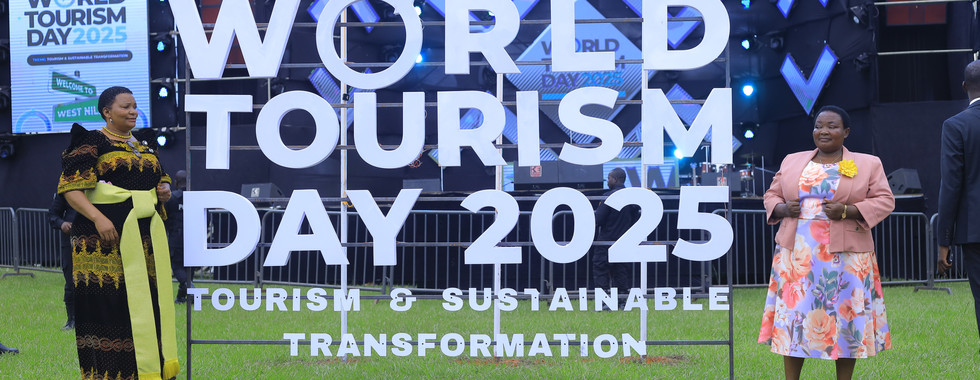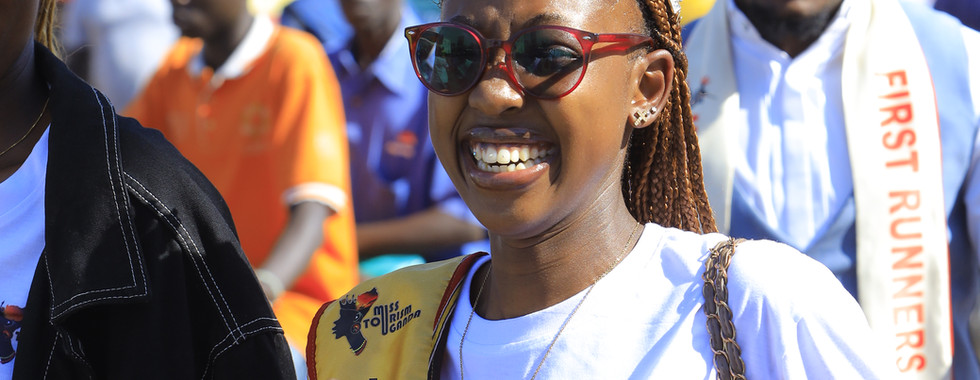Uganda Celebrates World Tourism Day 2025 in Arua: Showcasing Sustainable Transformation and Regional Potential
- mtwa tourism
- Sep 27
- 5 min read

On 27th September 2025, the vibrant city of Arua hosted the national celebrations of World Tourism Day, marking a historic moment for the West Nile region. The event, held at the scenic Arua City Golf Course, brought together dignitaries, government officials, international guests, and communities from across Uganda and neighbouring countries to commemorate the global tourism industry's impact and potential under the 2025 theme: “Tourism and Sustainable Transformation.”
Presiding over the celebrations as Chief Guest, Rt. Hon. Robinah Nabbanja, Prime Minister of the Republic of Uganda, commended the Ministry of Tourism, Wildlife and Antiquities and its agencies for their tireless work in positioning tourism at the heart of national development. She extended her heartfelt appreciation to the people of Arua and the broader West Nile region for their unmatched hospitality, cultural vibrance, and meticulous organisation, which made the celebration a resounding success. She also warmly welcomed delegates from the Democratic Republic of Congo and South Sudan, acknowledging the unique geographical positioning of Arua as a gateway to regional cooperation, cross-border tourism, and cultural exchange.
Reflecting on the theme of the year, the Prime Minister emphasised that tourism is more than leisure; it is a key economic engine. Globally contributing around 7% of world trade and ranking third among major export categories, tourism has proven resilient, with international arrivals continuing to rise post-pandemic. Uganda, too, has seen significant recovery and growth. In 2024, the country welcomed 1.37 million international visitors, reaching 89.2% of its pre-pandemic figures, and tourism expenditure surged by 26% to UGX 4.8 trillion (approximately USD 1.28 billion). This growth, she noted, presents not only opportunities but also responsibilities, particularly in embracing sustainability and innovation.

The Prime Minister highlighted four global megatrends shaping tourism's future: the evolving visitor demand with a preference for authentic, eco-friendly experiences; the imperative for sustainable tourism that preserves nature and culture; the integration of enabling technologies such as AI, drones, and digital marketing; and improved mobility through expanded transportation networks. Uganda is already embracing this transformation with increased adoption of electric motorbikes, solar energy, digital platforms, and smart conservation tools.
She challenged the Ministry to further promote technological innovation, especially through support for youth led tourism startups and smart surveillance in wildlife areas. Recognising tourism as a central pillar under the National Development Plan IV and Vision 2040, the government has laid out an ambitious strategy for a 25-fold increase in tourism earnings over the next decade. This commitment is evident through massive infrastructure investments, including the expansion of Entebbe International Airport, development of Kabale International Airport, upgrades of aerodromes in Arua, Kidepo, Jinja, Kasese, and Kisoro, and improvements in road networks, particularly the highway connecting Arua to the rest of the country. Marine transport has also seen enhancements with ferry services on the Nile and expanded access to Uganda’s lakes and rivers.
The government continues to offer a favourable investment climate through tax credits and financing for tourism related imports. Projects such as the Source of the Nile Development, Rwenzori Mountain infrastructure, redevelopment of Kitagata Hot Springs, Jinja Hotel and Tourism College, and the Uganda Museum are all part of the strategy to establish Uganda as a world class destination. In West Nile, plans are underway to revitalise Ajai Wildlife Reserve with the translocation of white rhinos by December 2025. The Prime Minister called upon the local communities and the Uganda Wildlife Authority to safeguard this valuable asset and introduce more wildlife species to elevate the reserve’s profile.

Uganda is also tapping into sports and entertainment tourism to enhance its global appeal. The successful bids to host CHAN 2025 and AFCON 2027 are expected to drive significant visitor traffic and economic gains. Initiatives like the Elgon and Rwenzori marathons, Oktoberfest in Gulu, Fort Portal’s Empako Festival, and Kampala’s City Festival were lauded for promoting city level innovation and competitiveness.
During the World Tourism Day event, outstanding contributors to the tourism sector were recognised through the Tourism Recognition of Excellence Awards. These awards celebrated both national champions and regional innovators across cultural tourism, agro-tourism, wildlife conservation, and investment. The Prime Minister underscored the importance of inclusion, urging stakeholders to ensure tourism benefits women, youth, and local communities while also addressing challenges such as climate change, deforestation, and pollution.
Hon. Tom Butime, Minister for Tourism, Wildlife and Antiquities, while addressing the gathering, reiterated the strategic role of Arua City and the wider West Nile region in Uganda’s tourism journey. He praised Arua for its transformation and hospitality, highlighting its unique mix of cultural and natural assets. He drew attention to pressing infrastructure needs such as the expansion of Arua Airstrip, road improvements, and reliable ferry services, calling for accelerated implementation to boost accessibility and competitiveness.

The Minister noted Uganda’s remarkable tourism performance in 2024, with tourists staying longer, averaging 8.7 nights, and spending more. Tourism now contributes approximately 5.7% to the national GDP and supports over 803,000 jobs. The rise of Meetings, Incentives, Conferences, and Events (MICE) tourism has also elevated Uganda’s profile on the global stage. As part of the country’s broader ATMS (Agro-industrialization, Tourism Development, Mineral Development, and Science and Technology and Innovation) strategy, tourism is targeted to grow foreign exchange earnings to $50 billion by 2040. The roadmap includes diversifying tourism products, investing in modern infrastructure, and equipping the workforce with world-class service skills.
West Nile’s readiness to contribute to this transformation was evident in the activities held across its 13 districts. Arua Central MP Atima Lee Jackson highlighted tourism-related community engagements and site preparations leading up to the celebrations. In Pakwach, key tourist sites include Wanglei (linked to the story of Nyipir and Labongo), Omach Pilgrimage site, Owiny Primary School’s Total Eclipse Site, Emin Pasha Fort, Pacer Blacksmith community, and fish landing sites at Panyimur.
In Nebbi, attractions such as the Catholic Church Cathedral, the uniquely small Bethel Church, Got-Nebbi Hills, Loj-jodong (burial site of Nyipir), Goli Border Customs, and Jukia Hills are being developed for tourism. Zombo district showcased the Alur Kingdom palace in Atiak, the Nyagak Power Plants, and thriving tea and coffee plantations with value addition sites. Madi Okollo district’s focus is on restoring Ajai Wildlife Reserve, fish landing sites along the Nile, the historic Cotton Ginnery in Rhino Camp, Madi Cultural Grounds, and Ajai FC managed by Uganda Wildlife Authority.

The Arua Central MP commended the Ministry for choosing West Nile to host this historic event, which hw described as the most significant in the region in 50 years. He reported ongoing restoration efforts and community ranger training and requested the tarmacking of Arua Airfield’s runway and support for Konyi war victims. He reaffirmed the region’s commitment to Uganda’s socio-economic transformation through tourism.
The celebrations in Arua showcased not only Uganda’s rich tourism potential but also its readiness to lead in sustainable tourism. From infrastructure to innovation, and from community empowerment to ecological stewardship, Uganda is committed to building a tourism industry that benefits all and secures the nation’s natural and cultural heritage for future generations.























































































































































































































